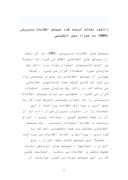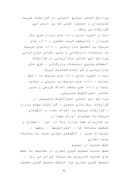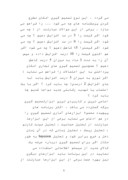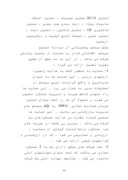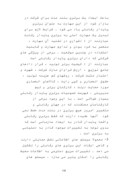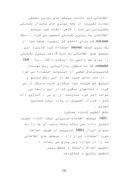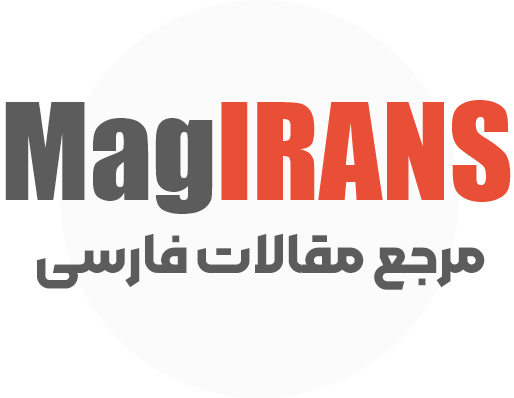بخشی از مقاله
دانلود مقاله ترجمه شده سيستم اطلاعات مديريتي (MIS) به همراه متن انگلیسی
سيستم هاي اطلاعات مديريتي (MIS) به آن دسته از سيستم هاي اطلاعاتي اطلاق مي گردد كه معمولا بر اساس كامپيوتر استوار بوده ودر داخل يك سازمان مورد استفاده قرار مي گيرد . شبكه جهاني از سيستم اطلاعاتي به عنوان سيستمي ياد مي كند كه شامل شبكه همه كانالهاي اطلاعاتي مي باشد كه در داخل يك سازمان مورد استفاده قرار مي گيرد . همچنين مي توان سيستم اطلاعات مديريتي را به عنوان سيستمي تعريف كرد كه به جمع آوري و پردازش
اطلاعات پرداخته و اين اطلاعات را در اختيار مديران قرار داده تا از آن در جهت تصميم گيري ، برنامه ريزي ، اجراي برنامه و نظارت استفاده نمايند . يك سيستم اطلاعاتي مشتمل بر همه بخشهايي است كه به گردآوري ، پردازش و اشاعه اطلاعات مي پردازند . معمولا اين سيستم شامل سخت افزار ، نرم افزار ، انسانها ، سيستم هاي ارتباطي مانند خطوط تلفن و اطلاعات مي باشند . فعاليت هايي كه در اين سيستم صورت مي گيرد عبارتند از وارد كردن داده ها ، پردازش داده به اطلاعات ، ذخيره سازي داده ها و اطلاعات و توليد خروجي هايي از قبيل گزارشات مديريتي .
از سيستم اطلاعات تحت عنوان مديريت تكنولوژي اطلاعات ياد مي شود .معمولا مطالعه سيستم هاي اطلاعاتي جزء رشته مديريت بازرگاني بوده و شامل برنامه ريزي و اجراي برنامه هاي نرم افزاري مي شود . بنابراين حوزه از مطالعات با دانش كامپيوتر يا مهندسي كامپيوتر اشتباه شود . دانش كامپيوتر از نظر ماهيت بيشتر نظري بوده و در رابط با توليد نرم افزار مي باشد و مهندسي كامپيوتر نيز بيشتر بر طراحي سخت افزار هاي كامپيوتري تمركز دارد .
در بازرگاني سيستمهاي اطلاعاتي روشها و عملكردهاي تجاري ، تصميم گيري و استراتژي
هاي رقابتي را پشتيباني مي كند .
فهرست مطالب
1 – نقش حمايت كاربردي
2- نقش حمايت از تصميم
3- نقش حمايت از تصميم
4- نقش تنظيم كننده عملكرد
5- MIS به عنوان يك ناهنجاري انعطاف پذير
6- توسعه تاريخي
7- برخي از برنامه هاي شناخته شده فعلي در سيستم هاي اطلاعاتي
8- انجمن ها و گروهها
9- منابع اطلاعات در MIS
نقش حمايت كاربردي
روش ها و عملكردهاي تجاري از عملي پشتيباني مي كند كه به عنوان اساسي ترين كاركرد محسوب مي گردد . اين عملكردها شامل جمع آوري ، ثبت ، ذخيره
سازي و پردازش اطلاعات مي باشد . سيستم هاي اطلاعاتي به يكي از روشهاي زير از روش ها و عملكردهاي تجاري پشتيباني مي كند .
ثبت و ذخيره سازي داده هاي فروشي ، داده هاي خريد ، داده هاي سرمايه گذاري ، داده هاي كل و دستمزد پرداختي و ساير دفاتر حسابداري
پردازش اين دفاتر حسابداري در گزارش هاي در آمد ، ترازنامه ، دفاتر حساب ، گزارشهاي مديريت و ساير گونه هاي اطلاعاتي مالي
ثبت و ذخيره سازي داده هاي فهرست موجودي ،پردازش داده ها ، اصلاح دانش و حفظ و نگهداري داده ها فراهم كردن زنجيره داده ها و ساير دفاتر توليد عملكرد
پردازش اين دفاتر عملكرد در طرح هاي توليدي ، ناظران توليد ، سيستم هاي فهرست موجودي و سيستم هاي تنظيم كننده توليد :
ثبت و ذخيره سازي داده هاي مربوط به كاركنان ، داده هاي مربوط به حقوق كاركنان ، تاريخچه اشتغال و ساير دفاتر منابع انساني
پردازش دفاتر منابع انساني در گزارشات هزينه كارمندان و عملكرد هايي كه بر اساس اين گزارشات مي باشد .
ثبت و ذخيره سازي داده هاي بازار شرح حال خريدار ، تاريخچه خريد مشتري ، داده هاي مربوط به تحقيق بازاريابي ، داده هاي مربوط به تبليغات بازرگاني و ساير دفاتر بازرايابي
پردازش اين دفاتر بازاريابي در گزارشات انعطاف پذيري تبليغات بازرگاني ، طرح هاي بازاريابي و گزارشات فعاليت فروش
ثبت و ذخيره سازي داده هاي مربوط به دانش تجارت ، داده هاي مربوط به بررسي و تحليل رقبا و داده هاي صنعت اهداف گروهي و ساير دفاتر استراتژيك مديريتي
پردازش اين دفاتر استراتژيك مديريتي در گزارشات روش مالي صنعتي ، گزارشات سهام بازار ، گزارشات مربوط به اهداف عمده و الگوهاي مربوط به موجودي اوراق بهادار
به كاربران همه موارد بالا در اجرا ، نظارت و تنظيم برنامه ها ، استراتژيها ، روشها ، توليدات جديد ، الگوهاي تجاري جديد يا معاملات جديد تجاري
نقش حمايت از تصميم
نقش حمايت تصميم گيري تجاري در مقايسه با نقش هاي حمايت كاربردي يك مرحله فراتر مي رود . تصميم گيري تجاري جزء لاينفك تصميم گيري محسوب مي گردد . اين نوع تصميم گيري امكان مطرح كردن پرسشنامه هاي چه مي شود ... را فراهم مي سازد . برخي از اين سوالات عبارتند از : چه مي شود اگر قيمت را 5 در صد افزايش دهيم ؟ چه مي شود اگر قيمت را 0 در صد افزايشصد افزايش داده و سپس آن را به مدت 3 ماه به ميزان 5 درصد كاهش دهيم ؟ همچنين تصميم گيري هاي تجاري امكان پرداختن به اين احتمالات را فراهم مي نمايد : اگر تورم به ميزان 5 درصد افزايش يابد (به جاي افزايش 2 درصدي) چه بايد كرد ؟ اگر با يك اعتصاب يا تهديد رقابترنامه هاي پيچيده معمولا ابزارهاي آماري تصميم گيري را در هم ادغام مي نمايد برخي از اين ابزارها عبارتند از تحليل حساسيت ، تحليل مونت كارلو ، تحليل ريسك ، تحليل زماني كه در آن زمان دخل و خرج برابر شود و تحليل bayesion به طور مثال اگر براي تصميم گيري درباره عرضه يك كالاي جديد از سيستم اطلاعاتي استفاده مي نماييد در اين برنامه بايد ابزارهاي ديگري نيز بهره جست برخي از اين ابزارها عبارتند از تحليل B.C.G تحليل همبسته ، تحليل اختلاف ماليات ويژه ، درجه بندي چند بعدي ، تحليل فاكتوري GE ، تحليل فاكتور ، تحليل دسته ، تحليل مميز ، توسعه تابع كيفيت و درگرسيون ارجحيت
نقش سيستم پشتيباني از مبادله تصميم
سيستم اطلاعاتي قادر به حمايت از وضعيت رقابتي شركت مي باشد . در اين جا سه سطح از سطوح تجزيه تجليل ارائه مي گردد :
1- حمايت به منظور كمك به هدايت زنجيره ارزشهاي دروني . اين حمايت ها به عنوان جديدترين و واقع گرايانه ترين سيستم در تحقيقات مدير به شمار مي رود . اين حمايت ها راه حلهاي كاهش هزينه و مديريت عملكرد محسوب مي شوند و معمولا آن ها را تحت عنوان تحليل جريان فعاليت تجاري (BWA) يا p2p سيستم هاي مديريت بازرگاني مي نامند . اين حمايت ها تضمين كننده نظارت بر هدايت عملكردهاي يك شركت مي باشد . برتري بي وقفه در هزينه هاي سوء عملكرد باعث فاصله گرفتن از محاسبه ، ارزيابي و حسابرسي مي شود . كه در ارزشيابي و گزارشهاي كيفي ارائه مي شود .
2- همه شركت هاي موفق داراي يك يا 2 عملكرد تجاري مي باشند كه تحت عنوان مهارتهاي اصلي ناميده مي شود . چنانچه مهارت اصلي يك شركت باعث ايجاد يك برتري بلند مدت براي شركت در بازار شود از اين مهارت به عنوان برتري پايدار رقابتي ياد مي شود . شرايط لازم براي تبديل يك مهارت اصلي به برتري پايدار رقابت عبارتند از : دشواري در تقليد آن مهارت ، منحصر به فرد بودن و تداوم مهارت و قابليت استفاده در چندين موقعيت . برخي از ويژگي هاي شركتي كه داراي برتري پايدار رقابتي است عبارتند از : كيفيت برتر توليد ، قرار دادهاي جامع توزيع ، ارزش فراوان مارك شركت ، شهرت و اعتبار مثبت شركت ، روشهاي كم هزينه توليد ، حقوق انحصاري و كپي رايت ،
كالاهاي انحصاري مورد حمايت دولت ، كاركنان برتر و تيم مديريتي . فهرست خصوصيات برتري پايدار رقابتي بسيار طولاني است . با اين وجود برخي از كارشناسان معتقدند كه در جهان رقابتي و متغيير امروز هيچ برتري در بلند مدت حفظ نمي شود آنها عقيده دارند كه فقط برتري رقابتي واقعا پايدار قادر به ايجاد سازماني است كه بدون توجه به تغييرات موجود قادر به دستيابي به برتري است . تشكيل مي دهد . تغييرات سريع دسترسي به اطلاعات محيط رقابتي را امكان پذير مي سازد . سيستم هاي اطلاعاتي نيز مانند سيستم هاي بررسي محيطي تجارت تقريبا از همه برتري هاي پايدار رقابتي پشتيباني مي كند . گاهي اوقات خود سيستم اطلاعاتي يك برتري رقابتي محسوب مي گردد . مثلا wal-mart كه براي ادغام كل زنجيره عرضه خود از يك برون شبكه internet استفاده كرد كاربرد اين سيستم هاي اطلاعاتي به مدت 2 دهه برتري رقابتي را براي سم والتن به ارمغان داشت . يا Dell – computer كه به منظور بازاريابي روش مونتاژ كامپيوترهاي شخصي از اينترنت استفاده مي كرد . در حال حاضر هنوز هم در اين روش توزيع و تبليغ كم هزينه سود سرشاري عايد مايكل دل مي گردد . مثالهاي ديگري كه در اين رابطه مي تواند ذكر كرد عبارتند از اي بي ، آمازون دات كام ، فدرال اكسپرس در باره روند فعاليت تجاري .
نقش تنظيم كننده عملكرد
(MIS) سيستم اطلاعات مديريتي صرفا آماده تجزيه تحليل داده نمي باشد بلكه بايد آن ها را به عنوان ابزار MBO (مديريت از طريق اهداف) مورد استفاده قرار داد . سيستم هاي اطلاعاتي ما را در موارد زير ياري مي رساند :
تعيين اهداف وابسته و سنجش پذير
تنظيم نتايج و عملكردها
هشدار به همه مديران در هر سطحي از سازمان ، اين هشدارها در ارتباط با تناقض ميان نتايج و اهداف بودجه هاي از پيش تعيين شده است .
MIS به عنوان يك ناهنجاري انعطاف پذير
براي شركتي كه در تكنولوژي اطلاعات سرمايه گذاري كرده است چندين راه وجود دارد تا به منظور ايجاد رشد يا حفظ انعطاف پذيري ناهنجاري اين سرمايه گذاري را با رهن گذاري جور كند .
1- سرمايه گذاري IT (تكنولوژي اطلاعات) كه از مهارت اصلي شركت حمايت مي نمايد . شركتهاي موفق تمايل دارند كه از يك يا دو مهارت اصلي برخوردار باشند كه در مقايسه با ساير اين مهارت ها را بهتر انجام دهند . اين مهارت ها طيف وسيعي از فعاليت ها را شامل مي گردد كه اين طيف از توسعه كالاهاي جديد يا خدمات خريدار را در بر مي گيرد . معمولا تكنولوژي اطلاعات داده مهمي در اين مهارت اصلي محسوب مي شود . سرمايه گذاري IT در يكي از مهارت هاي اصلي شركت مانع مهمي در ورود به شمار مي رود .
2- سرمايه گذاري IT در شبكه هاي زنجيره عرضه شركتهايي كه بخشي از يك زنجيره عرضه ادغام شده هستند به عرضه كنندگان اعتماد دارند . معمولا اين اعتماد پذيري باعث زمان تحويل سريعتر ، تحويل بدون اشكال و يك عرضه تضمين شده مي گردد . همچنين اين حس با اعتماد تخفيف قيمت و رفتارهاي خاص ديگري را در پي دارد . ناتواني تازه واردان جديد در سيستم مديريت موجودي زنجيره عرضه به عنوان مانع اصلي ورود محسوب مي گردد .
3- سرمايه گذاري IT مديريت شبكه توزيع سرمايه گذاري در سيستم هاي مديريت شبكه توزيع نيز مانند ساير شبكه هاي عرضه كننده تضمين كننده زمان تحويل سريع تر ، تحويل بدون اشكال و رفتارهاي خاص ديگر است . سرمايه گذاري در تكنولوژي اطلاعات و تجربه نحوه استفاده آن به عنوان مانع اصلي ورود محسوب مي گردد . وقتي سيستم مديريت شبكه توزيع اعضا مي باشد . مي توان دسترسي به خرده فروشان را تحت كنترل داشت .
4- سرمايه گذاري IT در ارزش ويژه مدرك معمولا شركتها مبالغ هنگفتي را صرف تبليغات مارك مي نمايند . اين كار با سرمايه گذاري در بازاريابي سيستم هاي اطلاعاتي و سيستم مديريت روابط خريدار تسهيل مي شود . يك مارك خوب و معروف نيز مانع دشواري براي ورود محسوب مي گردد.
5- سرمايه گذاري IT در فرآيند توليد سيستم هاي توليد به عنوان يك ضرورت در مديريت توليد انبوه به شمار مي رود . سيستم هاي خودكار مقرون به صرفه ترين روش براي سازماندهي فرايند هاي توليد انبوه مي باشد .
اين شركت ها قادرند كه در تبليغ ، خريد و فروش به اقتصاد معيار و در توزيع و تبليغ ، بودجه كاهش يافته هزينه هاي غير توليدي در هر واحد و كوتاه تر شدن زماني كه دخل و خرج با هم برابر مي شود به اقتصاد هدف دست يابند . اين برتري مطلق هزينه نيز به عنوان يكي از موانع اصلي ورود به شما مي رود .
6- سرمايه گذاري IT در فرآيند هاي توليد سرمايه گذاري در IT انعطاف پذيري شركت را در سطح توليد سرتاسري امكان پذير مي سازد . مايكل پرتر معتقد است كه علاوه بر برتري مطلق هزينه ، اقتصاد معيار نيز به عنوان مانع ورود محسوب مي شود . زيرا براي شركتي كه در مرحله اي از منحني هزينه متوسط بلند مدت در حال توليد مي باشد ( در حضور اقتصاد معيار) امكان پس انداز هزينه در آينده وجود دارد و همين امكان يكي از موانع ورود محسوب مي گردد .
7- منحني يادگيري سرمايه گذاري با پول قرضي از تجاربي كه در رابطه با IT بهره مند مي
گردد . وقتي شركتي با به كاربردن سيستم هاي IT به تجربه اي دست مي يابد با مجموه اي از بهترين روشها آشنا مي شود كه ساير شركت هاي صنعتي با اين روش ها كمابيش آشنا هستند . شركتهاي غير صنعتي معمولا با جنبه هاي خاص به كارگيري اين سيستم ها آشنايي چنداني ندارند . تازه واردهاي جديد در وضع نامساعدي قرار خواهند گرفت مگر اين كه آن ها بهترين روشهاي صنايع و پيشرفت هاي موجود در شركت را دوباره تعريف نمايند .
8- سرمايه گذاري IT در فرايند توليد انبوه كالاهاي سفارشي تكنولوژي توليد كنترل شده IT باعث تسهيل توليد كالاهاي سفارشي گروهي ، تطابق پذير ، آشكار يا سطحي مي شود . اين انعطاف پذيري باعث افزايش دارايي خالص و رضايت خريدار مي شود و از آن به عنوان يكي از موانع اصلي ورود ياد مي شود .
9- سرمايه گذاري IT در كامپيوتر به طرح 6 كمك كرد . سيستم هاي CAD توسعه سريع و عرضه كالاهاي جديد را تسهيل مي كند . اين موضوع باعث ايجاد تفاوت هاي اختصاصي كالا مي شود . تفكيك محصول نيز به عنوان يك مانع ورود به شمار مي رود .
10 – سرمايه گذاري IT در كامپيوتر به طرح 2 كمك كرد . سيستم هاي CAD توسعه سريع و عرضه كالاهاي جديد را تسهيل مي كند . تفاوت هاي اختصاصي كالا براي ايجاد تناقض ميان كالا هاي رقابتي به كار مي رود . اين تناقض ها نيز در افزايش هزينه هاي انتقال خريداران بسيار موثر است. هزينه هاي بالاي انتقال خريدار مانع ارزشمندي براي ورود به شمار مي رود .
11- سرمايه گذاري IT در اقتصاد الكترونيك مي تواند وب سايت شركت را براي علايق و انتظارات و نيازهاي خريداران اختصاصي كرد . همچنين مي توان از وب سايت شركت در جهت ايجاد مفهوم وحدت و يگانگي استفاده كرد و هر دوي اين امور در جهت افزايش صداقت و وفاداري به كار مي رود . صداقت خريدار نيز مانع مهمي براي ورود محسوب مي شود .
12- سرمايه گذاري IT در برقراري ثبات توازن . شركتهايي كه از نظر تكنولوژي بسيار پيچيده هستند از طريق ارتباطات الكترونيك با خريداران عرضه كنندگان و سايرين تماس برقرار مي كنند از ثبات بيشتري برخوردارند . اين ظاهر عظيم ثبات نيز مانعي براي ورود محسوب مي شود . خصوصا موضوع براي خدمات مالي مصداق پيدا مي كند .
13- اين حقيقت ساده كه سرمايه گذاري IT مستلزم صرف بودجه است باعث شده كه از آن به عنوان مانع ورود ياد كنند در واقع هر عاملي كه باعث افزايش پيش نيازهاي سرمايه گردد به عنوان مانعي براي ورود محسوب مي شود .
توسعه تاريخي :
نقش سيستم هاي اطلاعات تجاري در خلال 4 دهه گذشته بسيار تغيير يافته است .
در دهه آغازين (1950 و 1960) فقط بزرگترين سازمان ها استطاعت برخورداري از سيستم هاي الكترونيك پردازش اطلاعات را دارا بودند . از اين سيستم ها در جهت ثبت و ذخيره سازي داده هاي دفتري از قبيل ثبت روزانه ، دفاتر روزانه ويژه و دفاتر حساب استفاده مي شد . در واقع اين يك نقش حمايت عملكرد محسوب مي شد .
با آغاز دهه 1960 از سيستم هاي اطلاعات مديريت به منظور ايجاد دام
نه محدودي از گزارشات از پيش تعريف شده مانند گزارشات در آمد ، ترازنامه و گزارشات فروشي استفاده مي شد . در حقيقت اين سيستم ها در صدد بودن كه نقش حمايت تصميم گيري عمل نمايند اما قادر به انجام چنين كاري نبودند .
با آغاز دهه 1970 سيستم هاي حمايت تصميم عرضه شد . اين سيستم
هاي انتخاب از ميان چندين گزينش و وضعيت را امكان پذير مي كرد . با به كاربردن اين سيستم ها نه تنها كاربر مي توانست كه به دلخواه خروجي توليدات خود را ايجاد كند بلكه قادر بود كه براي نيازهاي ويژه خود برنامه ها را به طرز خاصي بسازد . اگرچه استفاده از اين سيستم ها مستلزم صرف هزينه است . به عنوان بخشي از توافق قرار دادي كامپيوترهاي بزرگ و به منظور برخورداري دائمي از توسعه دهنده سيستم IBM در سايت بايد هزينه اي پرداخت گردد .
پيشرفت عمده اي كه دهه 1980 صورت گرفت عبارت بود از محاسبه تمركززدايي به جاي برخورداري از يك كامپيوتر بزرگ براي انجام همه امور در سازمان تعداد زيادي كامپيوتر شخصي مورد استفاده قرار گرفت اين بدان معنا است كه به جاي محول كردن يك وظيفه به بخش كامپيوتر به منظور پردازش دسته و انتظار انجام شدن كار توسط متخصصان هر كاربر كامپيوتري در اختيار دارد كه برنامه هاي آن در راستاي اهداف شخصي خود به دلخواه ايجاد مي كند . بسياري از انسان هاي ضعيف با تغيير پذيري داده سامان هاي Dos عملكردهاي bios و برنامه ريزي دسته DOS به مخالفت
برخاستند . وقتي كه افراد از مهارت هاي جديد خود رضايت حاصل كردند همه اموري را كه سيستم قادر به انجام آن ها بود را شناسايي كردند . بر خلاف انتظارها كامپيوترها به جاي ايجاد يك اجتماع عاري از كاغذ توده فراواني از كاغذ را به وجود آوردند ، كه اكثر آن ها فاقد ارزش بودند . در دهه 1980 با ارائه سيستم هاي اجرايي اطلاعات تا حدودي از حجم اين اطلاعات كاسته شد . با ارائه اين سيستم ها بر كارايي فعاليت ها افزوده شد . در دهه 1980 نخستين كاربرد تجاري روشها
ي تجاري هوش مصنوعي در فرم سيستم هاي متخصص عرضه شد . اين برنامه ها درباره موضوعات بسيار محدودي توصيه هايي را ارائه مي كرد . براي اولين بار وعده حمايت تصميم گيري در دهه 1960 در سيستم هاي اطلاعاتي مديريت به كار رفت و به تدريج به بهره وري رسيد .
در دهه 1990 سيستم هاي اطلاعات استراتژيك عرضه شد كه عمدتا به خاطر توسعه موضوعات مديريت استراتژيك توسط متخصصاني چون ام . پرتر ، تي . پيترز ، جي ، ريس ، هلي ، ماركيدس و جي . برني در دهه 1980 بود . برتري رقابتي به عنوان يك موضوع مهم مديريتي مطرح مي شد ، توسعه دهندگان نرم افزار از ايجاد چنين ابزارهاي بسيار خرسند بودند .
در حال حاضر نقش سيستم هاي اطلاعات تجاري گسترش يافته و حمايت استراتژيك را نيز در بر مي گيرد . جديدترين اقدامي كه در اين زمينه صورت گرفته عبارتند از : جنبه هاي تجاري دادن به اينترنت ، رشد اينترنت و اكسترانت.
Management information system
(MIS)
From Wikipedia, the free encyclopedia.
(Redirected from Management Information Systems)
Jump to: navigation, search
Management Information Systems (MIS) are information systems, typically computer-based, that are used within an organization. WordNet describes an information system as "a system consisting of the network of all communication channels used within an organization". A management information system may also be defined as "a system that collects and processes data (information) and provides it to managers at all levels who use it for decision making, planning, program implementation, and control." An information system is comprised of all the components that collect, manipulate, and disseminate data or information. It usually includes hardware, software, people, communications systems such as telephone lines, and the data itself. The activities involved include inputting data, processing of data into information, storage of data and information, and the production of outputs such as management reports.
As an area of study it is commonly referred to as information technology management. The study of information systems is usually a commerce and business administration
discipline, and frequently involves software engineering, but also distinguishes itself by concentrating on the integration of computer systems with the aims of the organization. The area of study should not be confused with [Computer Science] which is more theoretical in nature and deals mainly with software creation, or [Computer Engineering], which focuses more on the design of computer hardware.
In business, information systems support business processes and operations, decision-making, and competitive strategies.
Contents
[hide]
• 1 The functional support role
• 2 The decision support role
• 3 The communication decision support system role
• 4 The performance monitoring role
• 5 MIS as an elastic anomaly
• 6 Historical development
• 7 Some currently well-known programs in information systems
• 8 Associations and groups
• 9 Sources of information on MIS
• 10 See also
[edit]
The functional support role
The business processes and operations support function is the most basic. It involves collecting, recording, storing, and basic processing of data. Information systems support business processes and operations by:
• recording and storing sales data, purchase data, investment data, payroll data and other accounting records
• processing these accounting records into income statements, balance sheets, ledgers, management repor
ts, and other forms of financial information
• recording and storing inventory data, work in process data, equipment repair and maintenance data, supply chain data, and other production/operations records
• processing these operations records into production schedules, production controllers, inventory systems, and production monitoring systems
• recording and storing personnel data, salary data, employment histories, and other human resources records
• processing these human resources records into employee expense reports, and performance based reports
• recording and storing market data, customer profiles, customer purchase histories, marketing research data, advertising data, and other marketing records
• processing these marketing records into advertising elasticity reports, marketing plans, and sales activity reports
• recording and storing business intelligence data, competitor analysis data, industry data, corporate objectives, and other strategic management records
• processing these strategic management records into industry trends reports, market share reports, mission statements, and portfolio models
• use of all the above to implement, control, and monitor plans, strategies, tactics, new products, new business models or new business ventures.
[edit]
The decision support role
The business decision making support function goes one step further. It is an integral part of making decisions. It allows users to ask "What if…?" questions: What if we increase the price by 5%? What if we increase price by 10%? What if we decrease price by 5%? What if we increase price by 10% now, then decrease it by 5% in three months? It also allows users to deal with contingencies: If inflation increases by 5% (instead of 2% as we are assuming), then what do we do? What do we do if we are faced with a strike or a new competitive threat?
The most basic and most versatile business decision making tool is the spreadsheet, but spreadsheets are not user friendly. More sophisticated programs often seamlessly incorporate statistical decision making tools like sensitivity analysis, Monte Carlo analysis, risk analysis, break even analysis and Bayesian analysis. If, for example, you are using the information system to decide about a new product introduction, the program should incorporate tools like logit analysis, B.C.G. Analysis, conjoint analysis, contribution margin analysis, multi dimensional scaling, G.E. Multi Factoral analysis, factor analysis, cluster analysis, discriminant analysis, Quality Function Deployment, preference regressions, and preference-rank translations.
[edit]
The communication decision support system role
Information systems can support a company's competitive positioning. Here are three levels of analysis:
1. The supports for help in piloting the chain of internal value. They are the most recent and the most pragmatic systems within the reach of the manager. They are the solutions to reductions of costs and management of performance. They are typically named "Business Workflow Analysis" (BWA) or of "Business Management Systems p2p". Tool networks, they ensure control over piloting the set functions of a company. The real-time mastery in the costs of dysfunctions cause distances from accounts, evaluation and accounting that are presented in the evaluation and qualitative reports.
2. All successful companies have one (or two) business functions that they do better than the competition. These are called core competencies. If a company's core competency gives it a long term advantage in the marketplace, it is referred to as a sustainable competitive advantage. For a core competency to become a sustainable co competition, and applicable to multiple situations. Examples of company characteristics that could constitute a sustainable competitive advantage include: superior product quality, extensive distribution contracts, accumulated brand equity and positive company reputation, low cost production techniques, patents and copyrights, government protected monopoly, and superior employees and management team. The list of potential sustainable competitive advantage characteristics is very long. However, some experts hold that in today's changing and competitive world, no advantage can be sustained in the long run. They argue that the only truly sustainable competitive advantage is to build an organization that is so alert and so agile that it will always be able to find an advantage, no matter what changes occur.
3. Information systems often support and occasionally constitute these competitive advantages. The rapid change has made access to timely and current information critical in a competitive environment. Information systems, like business environmental scanning systems, support almost all sustainable competitive advantages. Occasionally,
the information system itself is the competitive advantage. One example is Wal-Mart. They used an extranet to integrate their whole supply chain. This use of information systems gave Sam Walton a competitive advantage for two decades. Another example is Dell Computer. They used the internet to market custom assembled PC's. Michael Dell
is still benefitting from this low-cost promotion and distribution technique. Other examples are eBay, Amazon.com, Federal Express, and Business Workflow Analysis Oberon-bwa.
[edit]
The performance monitoring role
MIS are not just statistics and data analysis. They have to be used as an MBO (Management by Objectives) tool. They help:
• to establish relevant and measurable objectives
• to monitor results and performances (reach ratios)
• to send alerts, in some cases daily, to managers at each level of the organisation, on all deviations between results and pre-established objectives and budgets.
[edit]
MIS as an elastic anomaly
There are numerous ways that a company that has invested in information technology can leverage this investment to create, grow, or maintain elasticity of the anomaly.
1. Leverage IT investment that supports their core competency. Successful firms tend to have one or two core competencies that they can do better than their competitors. It may be anything from new product development to customer service. Information technology is often an important input into this core competency. This IT investment in a company's core competency can be a significant barrier to entry for other companies.
2. Leverage IT investment in supply chain networks. Firms that are a part of an integrated supply chain system have established relationships of trust with suppliers. This usually ensures quicker deliver times, problem-free delivery and an assured supply. It can also entail price discounts and other preferential treatment. The inability of new entrants to get onto a supply chain/inventory management system can be a major barrier to entry.
3. Leverage IT investment in distribution channel management. As with supplier networks, investment in distribution channel management systems can ensure quicker delivery times, problem free delivery, and preferential treatments. The investment in this technology, and the experience gained in learning how to use it, can be an important barrier to entry. When the distribution channel management system is exclusive, it may give you some control over access to the retailers involved.
4. Leverage IT investment in brand equity. Often firms have invested large sums of money in brand advertising. This is facilitated by investment in marketing information systems and customer relationship management system. An indomitable brand name is a formidable barrier to entry.
5. Leverage IT investment in production processes (1). Information systems have become a necessity in managing large production runs. Automated systems are the most cost efficient way of organizing large scale production processes. These firms can obtain economies of scale in promotion, purchasing, and production; economies of scope in distribution and promotion; reduced overhead allocation per unit; and shorter break-even times more easily. This absolute cost advantage can be an important barrier to entry.
6. Leverage IT investment in production processes (2). Investment in IT allows a
company flexibility in their overall output level. Michael Porter claims that economies of scale are a barrier to entry, aside from the absolute cost advantages they provide. This is because, a company producing at a point on the long-run average cost curve where economies of scale exist has the potential to obtain cost savings in the future, and this potential is a barrier to entry.
7. Leverage learning curve advantages from experience with IT. As a company gains experience using IT systems, they become familiar with a set of best practices that are more or less known to other firms in the industry. Firms outside the industry are generally not familiar with the industry specific aspects of using these systems. New entrants will be at a disadvantage unless they can redefine the industries best practices and leap-frog existing firms.
8. Leverage IT investment in mass customization production processes. IT controlled production technology can facilitate collaborative, adaptive, transparent, or cosmetic customization. This flexibility can increase margins, increase customer satisfaction, and be a significant barrier to entry.
9. Leverage IT investment in computer aided design (1). CAD systems facilitate the speedy development and introduction of new products. This can create proprietary product differences. Product differentiation can be a barrier to entry.
10. Leverage IT investment in computer aided design (2). CAD systems facilitate the speedy development and introduction of new products. Proprietary product differences can be used to create incompatibilities between competing products (as every
computer user knows). These incompatibilities increase consumers’ switching costs. High customer switching costs is a very valuable barrier to entry (Just ask Bill Gates.).
11. Leverage IT investment in E-commerce. Company web sites can be personalized to eac
h customers interests, expectations, and commercial needs. They can also be used to create a sense of community. Both of these tend to increase customer loyalty. Customer loyalty is an important barrier to entry.
12. Leverage IT investment in stability. Technologically sophisticated firms with multiple electronic points of contact with customers, suppliers, and others appear to be more stable. This monumental appearance of stability can be a barrier to entry. This is particularly true in financial services.
13. The simple fact that IT investment requires funds make it a barrier to entry. Anything that increases capital requirements is a barrier to entry.
[edit]
Historical development
The role of business information systems has changed and expanded over the last four decades.
In the incipient decade (1950s and '60s), “electronic data processing systems” could be afforded by only the largest organizations. They were used to record and store bookkeeping data such as journal entries, specialized journals, and ledger accounts. This was strictly an operations support role.
By the 1960s “management information systems” were used to generate a limited range of predefined reports, including income statements (they were called P & L’s back then), balance sheets and sales reports. They were trying to perform a decision making support role, but they were not up to the task.
By the 1970s “decision support systems” were introduced. They were interactive in the sense that they allowed the user to choose between numerous options and configurations. Not only was the user allowed to customize outputs, they also could configure the programs to their specific needs. There was a cost though. As part of your mainframe leasing agreement, you
typically had to pay to have an IBM system developer permanently on site.
The main development in the 1980s was the introduction of decentralized computing. Instead of having one large mainframe computer for the entire enterprise, numerous PC’s were spread around the organization. This meant that instead of submitting a job to the computer department for batch processing and waiting for the experts to perform the procedure, each user had their own computer that they could customize for their own purposes. Many poor souls fought with the vagaries of DOS protocols, BIOS functions, and DOS batch programming.
As people became comfortable with their new skills, they discovered all the things their system was capable of. Computers, instead of creating a paperless society, as was expected, produced mountains of paper, most of it valueless. Mounds of reports were generated just because it was possible to do so. This information overload was mitigated somewhat in the 1980s with the introduction of “executive information systems”. They streamlined the process, giving the executive exactly what they wanted, and only what they wanted.
The 1980s also saw the first commercial application of artificial intelligence techniques in the form of “expert systems”. These programs could give advice within a very limited subject area. The promise of decision making support, first attempted in management information systems back in the 1960s, had step-by-step, come to fruition.
The 1990s saw the introduction of “strategic information systems”. This was largely because of developments in the subject of strategic management by scholars like M. Porter, T Peters, J. Reise, C. Markides, and J. Barney in the 1980s. Competitive advantage became a hot management topic and software developers were happy to provide the tools.
The role of business information systems had now expanded to include strategic support. The latest step was the commercialization of the Internet, and the growth of intranets and extranets at the turn of the century.
http://en.wikipedia.org/wiki/Management_Information_Systems

